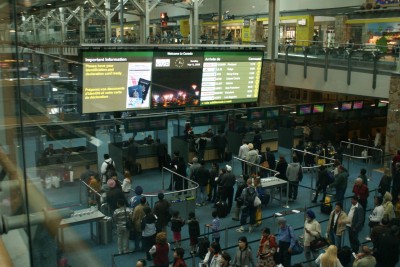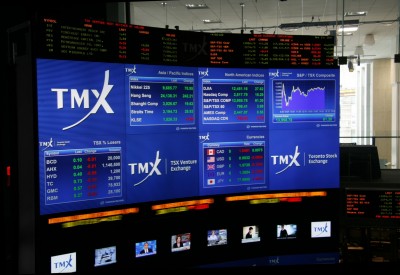Turning data into action
by all | 21 February 2014 8:51 am
 [1]
[1]Photos courtesy Omnivex
By Jeff Collard
As digital signage has developed into a mature medium, it has been used in new and unusual ways. Some companies, for example, use digital display systems to disseminate vital information about themselves to their employees, enabling them to make better, faster and smarter decisions at a glance. Such applications depend on unlocking the value of data-driven visual and experiential content to create a competitive advantage. In particular, the ability to turn ‘big data’ into actionable information is helping shape many business decisions today.
The Internet of things
The way people interact with information is changing, driven by consumer-oriented technologies. In the case of digital signage, the rapid growth of high-definition (HD) flat-panel televisions for consumers has resulted in display prices dropping, making the medium more affordable and accessible to virtually any commercial, corporate or institutional organization.
 [2]
[2]TMX, which owns and operates the Toronto Stock Exchange (TSE), runs live news and real-time financial data on its digital signs.
There has, of course, been an explosive growth of other digital devices in recent years, too. In 2014, estimates suggest seven billion people around the world will use some two billion computers, five billion smartphones and 10 billion other ‘smart devices.’
While this latter term may not be familiar, smart devices—i.e. those that can automatically communicate with each other—are all around. They are in homes, cars, offices and virtually everywhere else. Connected via the Internet, they are not only being remotely updated by their users, but also automatically sharing information with each other.
With this information freely moving across multiple devices in a new world of connected communications environments, online-connected digital signs are simply part of what British technology developer Kevin Ashton first described in 1999 as “the Internet of things.” In turn, this is dramatically changing how people interact with objects and each other.
The relationships between people and devices continue to evolve. As smart devices communicate with each other, they can provide users with more specifically customized experiences.
A connected experience
The Internet of things is not specific to any single industry or sector. Rather, it moves across vertical markets to provide a more connected experience for all of them.
The ability to tap into data in real time to support smarter business decisions and better customer experiences should drive further adoption of digital signage, but it will need to do so within the context of other devices and systems. As data becomes the ‘currency’ between devices and viewers, for example, cloud-based computing has become pivotal as the route for much of this data. So, digital signage communications strategies need to define a role for the cloud to play.
This does not necessarily mean all digital signage should be based on software-as-a-service (SaaS). Rather, as cloud-based computing forms part of most communications infrastructures in the future, systems will need to be able to support both premises- and cloud-based networks seamlessly.
User-generated content
It is clear user-generated content is burgeoning. According to Google vice-president (VP) Marissa Mayer, the amount has increased fifteenfold over the past few years.
While the term may be most closely associated with actively uploaded content on websites like Google’s own YouTube and various social media, however, user-generated content also includes much ‘passive’ data. Just as there are new social media, there are also new data sensors, types, volumes, technologies and economics.
 [3]
[3]Vancouver International Airport provides real-time flight information through digital signage at flight counters, in concourses and at customs and immigration points.
Retail chain Target, for example, has analyzed data gleaned from the purchasing habits of its customers. Based on certain changes in these habits and specific products, the company has been able to guess which female customers are expecting a baby and what point they have reached in their pregnancy.
This practice gained widespread attention after a man visited a Target store demanding to talk to the manager and asking why the store was sending leaflets and coupons to his teenage daughter that seemed to encourage her to get pregnant. As it turned out, Target knew the girl was pregnant before her parents did!
Floods of information
Data is powerful and there is only going to be much more of it available in the future, but it must be used in smart ways before it can improve business results. In digital signage messaging, especially, good content is certainly essential, but it is useless without the right focus and context.
The rapid pace and sheer volume of information people must process in any given day both dwarf any time in the past, so it is natural for viewers to adapt, cope and filter what they see. Good messaging can help facilitate their decisions, such as what shoes to buy or how to assemble parts in a factory. Studies suggest there is a limit to the number of good decisions an individual can make in a day, so the provision of timely information can have a significant effect on the decision-making process.
Fortunately, digital signage has been evolving as a medium for the past 20 years. It is already one of the best ways to deliver relevant information to the right people at the right places and at the right times. In some cases, even the simplest, least expensive digital signage system is more than adequate for a given communications strategy.
Today, however, many digital signage network owners want to achieve better returns and make their systems more easily manageable. They are looking to ‘intelligent systems’ that can improve the effectiveness of their existing investment in digital signage technology. A simpler system, by comparison, is less expensive to purchase, but can be more expensive to operate—and less effective at delivering targeted messages to the intended audience.
Enhancing intelligence
Intelligent systems create a unique experience at every point of contact, built around the needs of the viewer. As technology continues to advance, the infrastructure to make such systems viable is being put in place, but there must also be a stronger emphasis on content planning and execution.
For one thing, there are many communications systems available for reaching an audience. Often, a combination of these technologies will be needed if a message is truly going to be driven home.
In traditional marketing, for example, advertisers pay for space or time in mass media—such as television, radio, newspapers, magazines or billboards—to deliver one message to the largest possible audience. In today’s connected world, however, that audience has been introduced to more personalized media. If a retailer’s prospective customer owns a smartphone and carries it around at all times, it can become more difficult for the retailer to present a message. Indeed, the company must earn the right to do so.
 [4]
[4]Lamar Transit Advertising Canada operates an extensive digital signage network throughout Vancouver’s SkyTrain stations, featuring updated scheduling information within its communications mix.
This is a new era for many marketers. They must find a balance between paying for access to the highest number of customers and earning access to a higher level of engagement with individuals.
Digital signage, on the other hand, is a form of a third category, ‘targeted media.’ Screens are generally installed at a point of decision, where they can have some influence over a viewer’s experience. In this sense, the medium has come to represent a unique combination of relevant messaging, convenience and specific audience demographics, all of which can have a major effect on business processes.
To provide a more comprehensive medium, digital signage is now being enhanced with ‘intelligence’ based on a variety of conditions that can change on the fly. Software can make these decisions without back-end human intervention.
Rather, a smart system is ‘rules-based.’ And these rules may adjust parameters based on live data feeds or on input from the audience.
By manipulating variables, rules can determine the appropriate messaging for each display at a given time, for a given audience. The following are just a few examples of this ‘smart content.’
- Products or points of interest related to a user’s query through interactivity.
- Conditional information, such as the directions of escalators within a facility at certain times of day.
- Automatic updates when a store opens or an item goes on sale.
- The best and/or safest route for a driver to take, based on weather, traffic conditions and/or emergency notifications.
 [5]
[5]At the Vancouver Convention Centre, digital signage software is used to manage both signs and kiosks.
The overall goal of this approach is to make the content more relevant and accurate, while reducing the effort required to maintain it.
The need for relevance
In a flood of information, content needs to connect with its audience before it can have any impact. The relevance of that content provides a context for the viewer. So, an intelligent digital signage system that can target specific messaging to the right audience at its point of decision will be more effective than a passive one.
Further technological changes will occur in the future that cannot yet be predicted, but the ability to change information easily and inexpensively is an important investment, enabling the audience—whether customers, employees or others—to make more well-informed decisions within a more personalized experience.
Jeff Collard is president of Omnivex, a digital signage software developer based in Concord, Ont. For more information, visit www.omnivex.com[6].
- [Image]: http://www.signmedia.ca/wp-content/uploads/2014/03/Vancouver-customs.jpg
- [Image]: http://www.signmedia.ca/wp-content/uploads/2014/03/TMX.jpg
- [Image]: http://www.signmedia.ca/wp-content/uploads/2014/03/Omnivex-Digital-Signage-at-YVR_1360.jpg
- [Image]: http://www.signmedia.ca/wp-content/uploads/2014/03/Lamar-transit.jpg
- [Image]: http://www.signmedia.ca/wp-content/uploads/2014/03/vancouver-convention-center.jpg
- www.omnivex.com: http://www.omnivex.com
Source URL: https://www.signmedia.ca/turning-data-into-action/